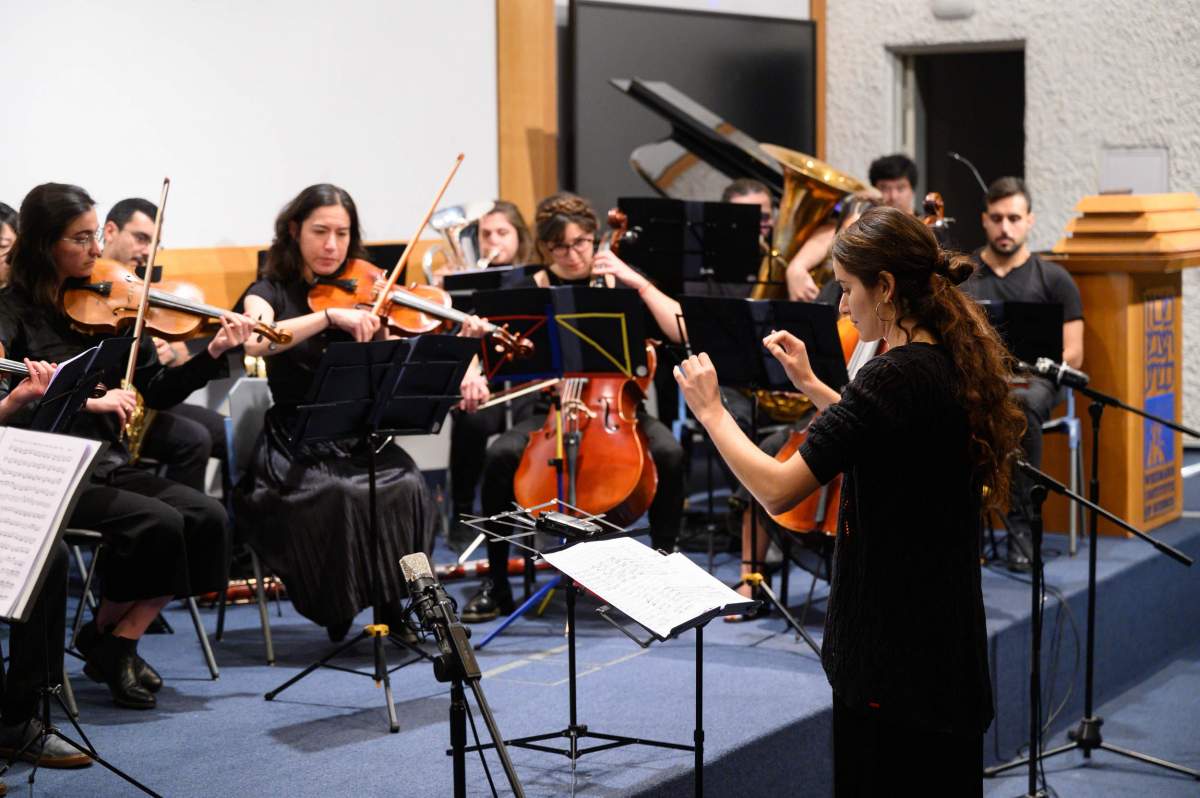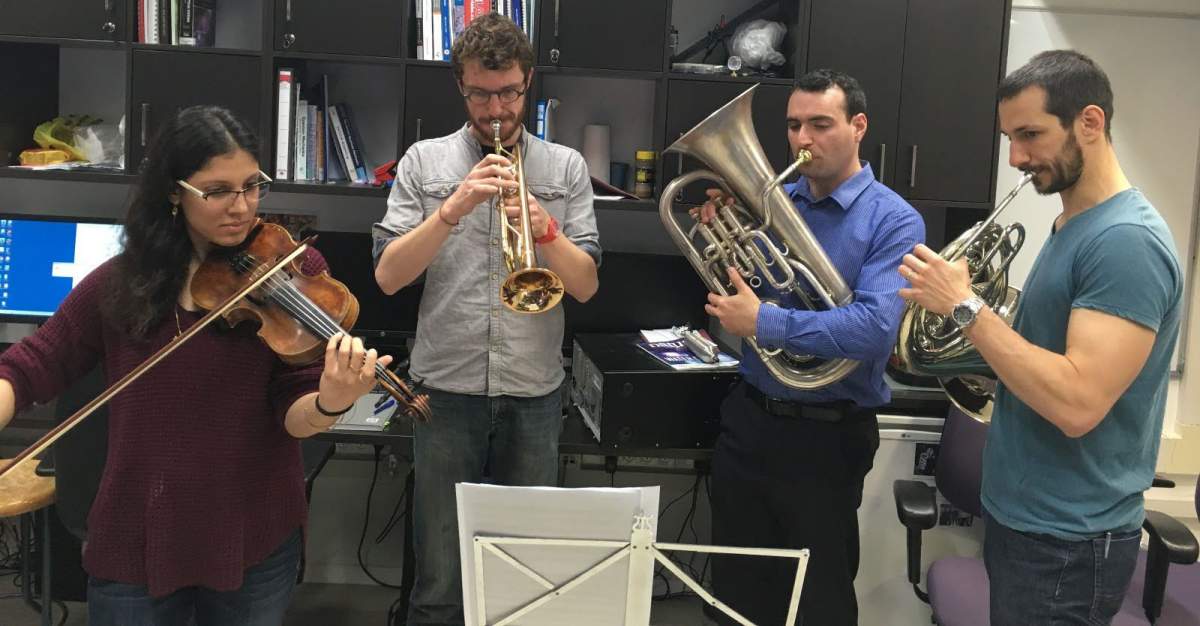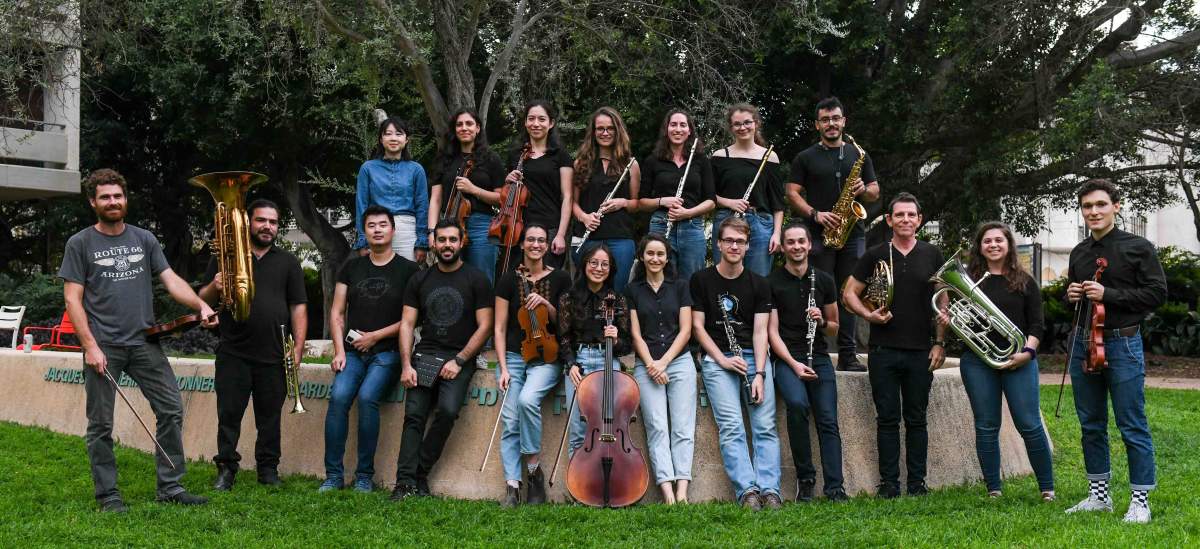Are you a journalist? Please sign up here for our press releases
Subscribe to our monthly newsletter:
Albert Einstein rarely travelled without his violin, which inspired him to develop the most elegant theories the world of science has seen. When he was a child, he learned to play piano and violin, and he continued playing his whole life. He even gave his violin an affectionate nickname: Lina.
“If I were not a physicist, I would probably be a musician,” he once said. “I often think in music. I live my daydreams in music. I see my life in terms of music.”
The 27 men and women who make up the Weizmann Orchestra – all of them students and scientists at the Weizmann Institute of Science – know exactly what Einstein meant. The orchestra’s winter concert, held in the Ebner Auditorium, was a huge success. The hall was packed, the musicians were excited and emotional, and the audience was thrilled by the performance. On the program were several pieces of chamber music by Mozart, as well as some orchestral works, including Bach’s Suite No. 3 in D Major and music from Bizet’s opera “Carmen.” Spurred by demand for tickets, the orchestra's summer concert on June 14 will be held in the larger Sela Auditorium.

Like Einstein, Tal Shahar Ohana, a doctoral student in the Chemical and Biological Physics Department, also takes her violin with her wherever she goes. Since arriving at the Weizmann Institute, she keeps it in the lab with her so she can play in the evenings after everyone else has gone home.
“When I came here in 2015,” she says, “I met a few other musicians who worked in labs on the ground floor of the Perlman Building and played together occasionally in the evening. They had an ensemble with a French horn, a trumpet, a Chinese violin and a euphonium. I joined them and we started to play pieces that suited our rather peculiar ensemble.”
"I have been playing since I was a child and I played in the Arad Chamber Orchestra for more than 20 years. I always wavered between having a career in music or the sciences"
These, she says, were the humble beginnings of what would become the Weizmann Orchestra. “We performed at all kinds of small events at the institute. We all have a musical background. I have been playing since I was a child and I played in the Arad Chamber Orchestra for more than 20 years. I always wavered between having a career in music or the sciences. But music is an integral part of who I am, and so are science and research, so I found a way to combine them.”
Shakked Schwartz, a doctoral student in the Molecular Chemistry and Materials Science Department, has played the flute since she was a child, and she studied in the music program at her Haifa high school. As soon as she arrived at the Perlman Building, she joined the ensemble – and decided to expand it. “When I got here, I thought to myself that there must be more musicians at the institute, so I put up notices in the building, and two or three more musicians joined us. After that, we sent out an email to many people at the institute, and in a single day we heard from another 10 musicians. Everyone was thrilled to discover that there are many more people for whom music is an integral part of their lives. It’s incredible how much it enriches people’s lives – even if they didn’t choose music as their profession.”
Dr. Benjamin Weiss, from France, is a postdoctoral fellow in the Biomolecular Sciences Department. He joined the orchestra as a clarinet player. “I started to learn the instrument when I was 10, and I played for nine years. After a 10-year break, during which I dedicated all my time to science, I was delighted to join the orchestra and start playing again.”

Alina Heukamp, a German doctoral student in the Brain Sciences Department, adds: “I’ve been playing the flute since I was a little girl, and I have even played with various orchestras. I stopped playing because I was so busy in the lab – and because there was no orchestra I could join. I’m so pleased that we have an orchestra here at the institute and that I was able to join it.”
Dr. Nir Kampf, a staff scientist in the Molecular Chemistry and Materials Science Department who joined the orchestra in 2019, adds that he has been playing the French horn since he was 8 years old.
“We have been meeting once a week for several years,” says Shakked. “Everybody looks forward to these sessions. We rehearse in the San Martin Faculty Clubhouse, where there’s a piano we can use. Before that, for the longest time someone would have to bring an electric piano on their back, and someone else would bring an amp. Not everyone has played in an orchestra before. It’s a unique experience, and we are learning together to play in sync. We do have a conductor. Rotem Marcel Azoulay, who plays the flute professionally and is studying to become a conductor, has been working with us for the past two years.”
"After a 10-year break, during which I dedicated all my time to science, I was delighted to join the orchestra and start playing again"
Rotem and Shakked studied together in their high school music program, and when Shakked heard what Rotem was studying, she immediately invited her to become the orchestra’s conductor. “In terms of the repertoire, we all propose pieces that might suit the ensemble and, together with us, the conductor selects the pieces that we will work on. We try to match the level of difficulty of the piece to all members of the orchestra. It’s an open space for everyone, and it’s also a sanctuary from work and from research. It’s uplifting and inspiring.”

Among the other members of the orchestra are: on violin – Mikhail Labendik (Russia), a student in the Condensed Matter Physics Department, Nadav Auerbach, a doctoral student in the same department, Ayelet Hasson, a student in the Chemical and Biological Physics Department, Assaf Lending, a student at the Hebrew University of Jerusalem’s Faculty of Agriculture in Rehovot, and Shachar Fraenkel, a doctoral student from Tel Aviv University; on piano – Qian Li (China), a student at the Hebrew University of Jerusalem’s Faculty of Agriculture, and Mariia Labendik (Russia), a doctoral student in the Condensed Matter Physics Department; on viola – Dr. Zipora Lansky, a research assistant in the Plant and Environmental Sciences Department, and Sivan Perez, a student at the Hebrew University of Jerusalem’s Faculty of Agriculture; on cello – Olivia Lucianno (Italy), a student in the Chemical and Structural Biology Department, and Rachel Joelle Bruch (Martinique), a student in the Particle Physics and Astrophysics Department; on clarinet – Jan Kadlec (Czech Republic), a doctoral student in the Brain Sciences Department, and Dr. Di Jin, a postdoctoral fellow in the Molecular Chemistry and Materials Science Department; on oboe – Dr. Itzik Dekel, a researcher at the Volcani Center; on bassoon and saxophone – Dr. Orlando Marin Artavia (Costa Rica), a postdoctoral fellow in the Chemical and Biological Physics Department; on euphonium – Shoshana Sernik (United States), a student in the Molecular Genetics Department; on tuba and trumpet – Michael Oren Perlstein, a student in the Mathematics Department; on mandolin – Hila Shtudiner, a budget officer in the Particle Physics and Astrophysics Department; on timpani – Dor Matsliyah, a student in the Plant and Environmental Sciences Department; and on flute – Antonia Kaestner (Germany), a student in the Chemical and Structural Biology Department.